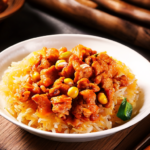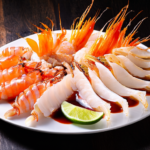Exploring the Flavors of Anhui: A Traditional Braised River Eel Delight
Welcome to another culinary adventure in the rich and diverse world of Chinese cuisine! Today, we delve into the flavors of Anhui province, where traditional cooking techniques and local ingredients come together to create dishes that are both comforting and exquisite. One such dish is the Braised River Eel, a classic Anhui specialty that has been enjoyed for generations. This recipe not only showcases the region’s unique taste profile but also provides an opportunity for home cooks to experience the essence of Anhui cuisine.
The History and Significance of Anhui Cuisine
Anhui cuisine, also known as Huizhou cuisine, is one of the eight major cuisines of China. It originates from the Huizhou region in southern Anhui and is characterized by its emphasis on preserving the natural flavors of ingredients, often using mountain herbs and river fish. The cuisine is famous for its simplicity, with a focus on freshness and the use of local produce. Braised River Eel is a prime example of this philosophy, highlighting the importance of slow-cooking methods to bring out the eel’s natural sweetness and texture.
Selecting the Right Ingredients
To prepare this dish, you will need fresh river eels, which are essential for capturing the authentic flavor of Anhui cuisine. When selecting your eels, look for ones that are lively and have clear, bright eyes. Freshness is key, so ensure they are sourced from reputable suppliers or markets. Additionally, you’ll need:
- Scallions (green onions)
- Ginger slices
- Garlic cloves
- Soy sauce
- Sugar
- Vinegar
- Shaoxing rice wine
- Starch
- Vegetable oil
- Hot water
- Sesame oil (optional)
These ingredients work harmoniously to enhance the eel’s natural taste while adding depth and complexity to the dish. Each component plays a vital role in balancing the flavors and ensuring the final product is both savory and slightly sweet.
Preparing the Ingredients
Before starting the cooking process, it’s important to properly prepare the eels. First, rinse them thoroughly under cold running water to remove any dirt or impurities. Next, use a sharp knife to make shallow cuts along the length of each eel, being careful not to cut through the skin. This helps in tenderizing the meat and allows the marinade to penetrate more effectively.
For the scallions, trim the roots and slice them into 2-inch segments. Peel and thinly slice the ginger, and crush the garlic cloves. Prepare a marinade by mixing soy sauce, sugar, vinegar, Shaoxing rice wine, and a small amount of starch in a bowl. This marinade will be used to coat the eels before braising, helping to lock in moisture and add flavor.
Cooking the Dish
Begin by heating a wok or large skillet over medium heat. Add a generous amount of vegetable oil and allow it to heat up. Once the oil is hot, carefully place the eels in the pan, skin-side down. Sear the eels for about 3-4 minutes on each side until they are golden brown and crispy. Remove the eels from the pan and set them aside on a plate.
In the same pan, reduce the heat to low and add the sliced ginger and crushed garlic. Stir-fry for about 1 minute until fragrant. Then, pour in the prepared marinade and stir well to combine all the ingredients. Bring the mixture to a simmer and return the seared eels to the pan. Cover the pan with a lid and let the eels braise gently for approximately 20-25 minutes, or until they are tender and fully cooked.
During the braising process, periodically check the liquid level and add hot water if necessary to prevent the eels from drying out. The goal is to achieve a thick, flavorful sauce that coats the eels perfectly. Once the eels are done, transfer them to a serving dish and garnish with the reserved scallion segments.
Serving Suggestions
Braised River Eel is traditionally served at room temperature, allowing the flavors to meld together further. It pairs wonderfully with steamed white rice or noodles, providing a satisfying contrast to the rich, savory eel. For a complete meal, consider serving it alongside a simple vegetable dish, such as stir-fried greens or sautéed mushrooms. The dish can also be enjoyed as part of a larger banquet or family gathering, where its elegant presentation and deep flavors make it a standout among other dishes.
Conclusion
By following this recipe, you can recreate the delightful flavors of Anhui’s Braised River Eel in your own kitchen. This dish not only offers a taste of traditional Chinese cuisine but also highlights the importance of using fresh, high-quality ingredients and mastering cooking techniques that enhance their natural qualities. Whether you’re a seasoned chef or a beginner in the kitchen, preparing Braised River Eel is sure to be a rewarding experience, bringing you closer to the rich culinary heritage of Anhui province.


